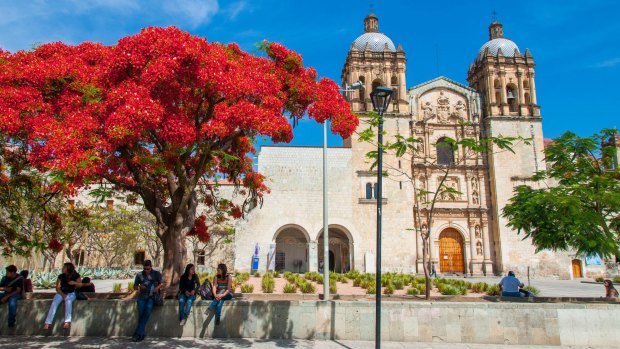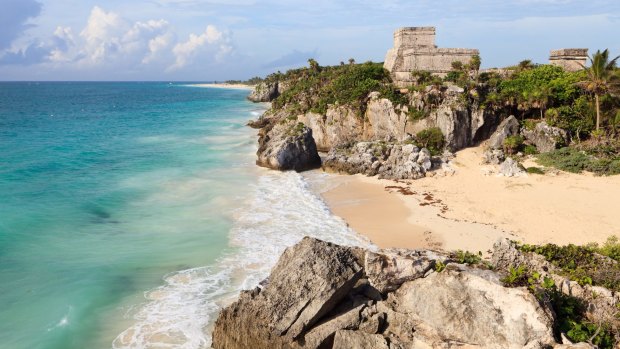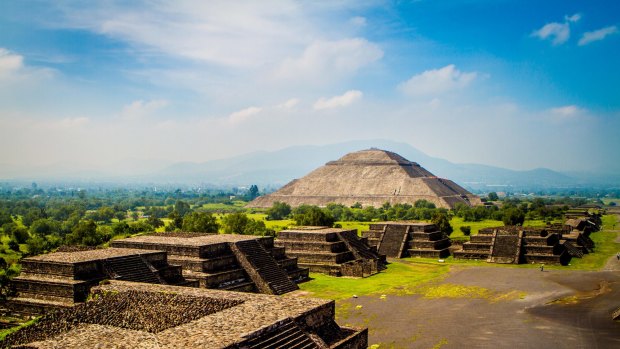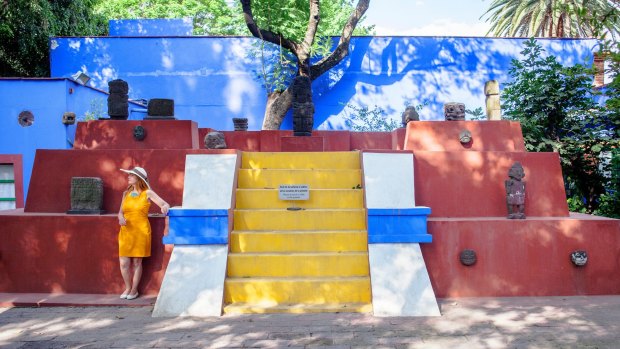This was published 4 years ago
Travel tips and advice for Mexico: Where to go, what to see, what to eat
By Alison Stewart

The church and convent of Santo Domingo de Guzman in the historic city centre of Oaxaca.Credit: Alamy
When I was 13 or so I went into a golden land ... I stood where Popocatepetl in the sunlight glows.
W.J. Turner's poem was my introduction to a mysterious land exotic beyond my youthful imagination. Now I have come to this shape-shifting land of Mexico to find that it is as dynamic as the place of my dreaming, sometimes gruelling, yes, but as astonishing as opening a nondescript door to a shining land.
We travel across 2150 kilometres and seven states, brushing the Gulf of Mexico, the Guatemalan border, from 3000-metre highlands laced with volcanoes (the haunting Popocatepetl), to humid sea level, from 39-degree heat to 16-degree hailstorms. Through this diverse land of the sacred jaguar, snake and eagle, we trace Mexico's convoluted path of history.

The Mayan Ruins at Tulum. Credit: Alamy
From the great seismic sinking bowl of Mexico City, into cactus lands, tropical jungles, past petrified limestone waterfalls, Spanish colonial towns and quaint pueblos, fields of agave, villages daubed in bold colours, turquoise sinkholes, ancient pyramids and temples.
Through layers of Mesoamerican civilisations – Olmec, Toltec, Mixtec, Mayan, Zapotec, Aztec, through wars of Spanish and US colonisation, plunder, suppression, corruption. Along gastronomic and artistic pathways, through webs of culture and mythology, across mountains and plains to the Caribbean.
Yet this quixotic land of my imagination, made concrete by experience, bears little relation to that described by the US President from the north, Donald Trump. His land is Latin America's Mordor, a nightmare place.

Pyramid of the Sun, Teotihuacan.Credit: Alamy
Trump's assaults on Mexico have been persistent. Late last month, President Trump threatened a 5 per cent tariff on all Mexican imported goods in a bid to force Mexico's hand on curbing illegal immigration. A tariff would have been economically catastrophic for both Mexico and the US. Trump "indefinitely suspended" the threat this week after Mexico agreed to tougher action.
Repeatedly disparaging Mexico, repeatedly asserting "We will build the wall" for which Mexico would pay, Trump claims the country is home to "bad hombres", drug dealers, criminals, illegals, thieves and rapists. And some have internalised this imagery – for them, Mexico is a no-go zone.
And there is some truth there. It can be dangerous. There is corruption. The mosaic of organised crime cartels locked in turf wars is real, though violence is generally "cartel on cartel or government on cartel".

The garden of the colouful Frida Kahlo museum in Coyoacan, Mexico City.Credit: Alamy
There is also some political unrest, including in the Zapatista area of Chiapas state, through which we travel at 4am to avoid extortion and roadblocks. There are refugees – many from Venezuela and Honduras, many escaping famine, political corruption and poverty, as refugees do.
And yes, it is sometimes punishing. Most of our travelling group at some point endures "Montezuma's revenge". One is hospitalised. The heat can be shocking, even for southern hemisphere souls. Some days are exhausting – eight hours in a minibus, early starts, late finishes. There's also dengue fever, Zika and malaria in places. Care must be taken; stamina and good health recommended.
But read on: this incredible country amazes and enfolds you. The people we meet are gentle, funny and obliging. They laugh about Trump, reducing him to "that clown north of the border". He is but another tremor in their movable history.
Mexico does not languish in the shadow from the north that stretches across the 1931-kilometre border, partly defined by the course of the Rio Grande and fronting California, Arizona, New Mexico and Texas. Currently, a barrier separates the two countries along about 1000 kilometres.
Mexico is far more than its Breaking Bad stereotype of sombreros, Tex-Mex tacos, nachos, burritos, enchiladas, chilli con carne, tequila, cactus, ponchos, dust and drugs.
Often there is little English – there are 289 individual languages spoken, including Spanish, Nahuatl (Uto-Aztecan), Yucatec Maya and Mixtec – but a great willingness to assist. And we travel with an irrepressible Mexican tour leader, Agatha Huerta, who, together with outstanding local guides, and our driver, former Mexico City police officer Sergio, interprets for our small, adventurous group this wonderful country.
Most have grown up knowing Europe and Asia, Africa and South America, often forgetting this land "south of the border" that has been so influential in the development of Western civilisation.
DAYS 1-2: MEXICO CITY
Flying into high-altitude Mexico City is like gliding over a Frida Kahlo embroidery – the colourful, low-rise metropolis ripples and glitters across the seismic basin that embraces 21.6 million of Mexico's 132 million people.
And it is to striking Casa Azul, the home of the country's revered artist, the bohemian intellectual Frida Kahlo, that we immediately go. Her naive folk art, inspired by Mexico's popular culture, for me symbolises the country.
In the vibrant colours beloved of Mexico, her art explores the quixotic nature of this country. She addresses post-colonialism, class, gender and race through the prism of her own identity.
We fly in, it must be said, with some trepidation. Is it safe? Yes, but stick to the better areas – the trendy, chic La Condesa, and gentrifying, art deco Roma Norte with its hipster cafes, murals and parks. Central Paseo de la Reforma and UNESCO heritage-listed Centro Historico, built over the ruins of the Aztec capital, Tenochtitlan, clustered around Plaza de la Constitucion with its cobbled streets and 16th-century European architecture.
Affluent Polanco, home to the fabulous Museum of Anthropology, and eclectic Coyoacan, once home to Frida Kahlo and her equally famous husband, muralist Diego Rivera. Not to mention our base, Zona Rosa, just west of the historic centre, known for its nightlife and gay community.
This city is a revelation, laced with green parks and grand boulevards, cobbled pedestrian areas and terrible traffic. It's arguably one of the world's most underrated cities, rich with architecture, a cultural and gastronomic paradise. It feels safe, the polite Mexicans rarely accost you and everywhere, even in this cosmopolitan city, their culture is dominant.
Flamboyant groups roam the night streets honouring the quinceanera – the coming of age of a 15-year-old, dressed often in a red gauze ball gown, with attendant jubilant entourage. The "fiesta de quince anos" has its cultural roots in Mesoamerica – the historic and cultural region that flourished before the Spanish conquistadors arrived in 1521. This region stretches south from central Mexico through Belize, Guatemala, El Salvador, Honduras, Nicaragua and northern Costa Rica.
You will find that cultural dominance in Mexico's food, which is rooted in the powerful pre-Hispanic culture. Culinary staples such as corn, beans, chillies, cactus and squash remain largely unchanged.
A prerequisite for Mexico travellers is the Museum of Anthropology. The building alone is magnificent, with a stylised central waterfall, representing the sacred ceiba tree of life, axis of the world in Mayan cosmology.
The museum summarises Mesoamerica's Pre-Classic (2500BC-250AD), Classic (250AD-900AD) and Post-Classic (900AD-1521AD) civilisations, covering sites we will visit.
Beginning with the southern migration of Palaeolithic hunter-gatherers from Eurasia about 13,000 years ago, the museum leads you from the Olmec "mother culture" (1400BC to 400BC) to the rise of the Maya, then the brief, fiery dominance of the Aztec, the last great civilisation before the Spanish arrived bringing Catholicism to replace indigenous belief systems and smallpox to all but obliterate the indigenous inhabitants. Spanish-Mexican relations remain touchy.
At the Palacio Nacional, we follow 1000 years of history through the politically charged Diego Rivera murals that illustrate the creation of an independent "mestizo" culture – a combination of European and indigenous American.
A walking tour reveals how the monumental neoclassical-baroque Metropolitan Cathedral, Mexico's seat of Catholicism, built dominantly atop an Aztec temple, is sinking and listing thanks to the city's watery seismic foundations.
Montezuma's (Moctezuma's) revenge? Moctezuma was the last Aztec king murdered by the conquistadors. A stone at the centre of the crypts is thought to be an Aztec altar used for human sacrifices.
DAYS 3-5: TEOTIHUACAN AND OAXACA
It takes three hours to negotiate Mexico City's early traffic for our drive north-east, back in time to the influential, multi-ethnic, pre-classic city of Teotihuacan.
Our guide is a descendant of the ancient inhabitants, who still practise head reformation – a cultural practice to signify group affiliation and social status – that artificially shapes the skull during childhood.
He is dismissive of the Johnny-come-lately Aztec.
Teotihuacan was established more than 2000 years ago, then abandoned due to volcanic eruptions long before the Aztec arrived. The metropolis, which dominated from 100BC to 650AD, was massive, the western hemisphere's largest city before the 1400s, covering 21 square kilometres and supporting up to 200,000 people.
Its remarkable pyramid temples (particularly the pyramids of the Sun and Moon, which we climb) are precisely aligned with solar and astronomical measures. They compare to Egypt's largest though they hold a gruesome bounty – layer upon layer of sacrificed souls, bound hands and feet, wearing grisly necklaces fashioned from jawbones and teeth.
It's another six hours through dry-season brown agave fields daubed with oleander, pepper trees and prickly pears to Oaxaca (pronounced Wahaca). We pass Spanish colonial Puebla and its attendant Popocatepetl, which last erupted earlier this year. Its spirit, Don Goyo, is said to appear when the volcano is angry.
And of course, the revered corn is as high as an elephant's eye. Mexicans have the world's highest per capita corn consumption, eating four times their body weight annually.
The majestic yellow mountains of the Sierra Madre de Oaxaca, clothed in sculptural cactus, escort us into central Mexico's Spanish colonial valley beauty of Oaxaca, basking in the glow of its many assets.
Apart from being ridiculously picturesque, Oaxaca has an impressive culinary history. There's the spiced bitter drinking chocolate, beloved of the Olmec, Maya and Aztec. There's the revered mezcal, first brewed in pre-Hispanic times, the delicious stringy Oaxaca cheese, crunchy crickets and grasshoppers or chapulines, Oaxaca-style tamales, seven varieties of mole sauce and delicious tlayudas – a large thin toasted tortilla covered with frijoles refritos, asiento (unrefined pork lard), cabbage or lettuce, avocado, chorizo, shredded chicken or beef, Oaxaca cheese and salsa.
We drive 70 kilometres east of the city past the heritage-listed Prehistoric Caves of Yagul and Mitla. Ten thousand-year-old squash seeds provide the continent's earliest evidence of domesticated plants. We're headed for the Hierve el Agua petrified tufa limestone waterfalls that cascade like luminous stalactites more than 50 metres into the valley.
It's a solid hike down through holm oaks and cactus, then a steep scramble back up to swim in the cliff-edge turquoise pools. This site, only recently discovered, was most likely a scared site to the ancient Oaxacan people. The Zapotec built irrigation channels and terraces about 2500 years ago, unique in Mesoamerica.
The stunning pre-Columbian Zapotec archaeological site of Mitla features elaborate mosaic fretwork and geometric designs that cover tombs, entire walls and panels, illuminating a sophisticated culture stretching back to 1000BC.
Unlike many of the other archaeological sites we visit, the Mitla buildings are not pyramids, but their intricate construction using finely cut and polished stone pieces, fitted together without mortar, is unique in Mexico. Consequently, earthquakes have not troubled these wonderful buildings.
As well as sophisticated engineering and beautiful architecture, the Zapotec had a developed writing system, two calendar systems and advanced agriculture. It's fitting then that we enjoy a late (perfectly acceptable in Mexico) 4pm Zapotec family lunch that includes memelas – toasted filled tortilla antojitos (snacks), guacamole, yellow mole tamales cooked inside corn leaves, hibiscus tea.
There's a Zapotec traditional weaving display, Mezcal tour and tasting (with ritual worms and chapulines) and finally, as the huge, cochineal-coloured sun boils towards the horizon, a stop-off at the world's oldest (more than 2000 years old) cypress, El Tule, whose massive girth is measured by 40 children holding hands.
We depart Oaxaca reluctantly, savouring the previous night's taste of those fresh market-made tlayudas con quesillo y chorizo. We're flying to Tuxtla (1800 metres high and 34 degrees), capital of Chiapas state, for the drive up past the huge natural Sumidero Canyon to the mountain city of San Cristobal de las Casas, Chiapas' cultural capital.
DAYS 6-8: SAN CRISTOBAL
This Mexican central highlands region is Maya territory, a place of extremes. We roast by day, then afternoon hailstorms plunge the temperatures to 13 degrees overnight. Night heaters replace airconditioners.
Colour is everywhere, expressing Mexico's exuberance. The markets dance with primary shades – crimson and jade chillies including the terrifying habanero, golden corn, rosy chorizo, purple onions, bright green nopal cactus paddles, vibrant limes, the purple or green prickly pear fruit called tuna, spiky green guanabana, pink pitaya and shiny, acidic nanches like tiny amber apples.
San Cristobal's traditional Chiapaneca dishes such as saffron tamales, sopa de pan (bread soup) and asado coleto (pork cooked with chillies and spices) are widespread.
It's not just the food – clothing is brightly embroidered and patterned, utensils and bowls dance with colour. Mexico lifts the spirits, like one big Frida Kahlo painting.
San Cristobal comes to the party with its baroque, neoclassical and Moorish flamenco facades in a riot of pinks, reds, greens, blues, violets and yellows. High-guttered cobblestone streets protect houses from the post-heat cloudbursts. Fireworks explode with startling regularity to celebrate, well, everything.
Designated a "Pueblo Magico" (magical village) in 2003, San Cristobal has been elevated to "the most magical of the pueblo magicos". Its cultural moniker derives from the large Indigenous population who craft the multicoloured textiles and local amber.
We head back in time to two of the many Mayan villages that speckle the surrounding mountains – San Juan Chamula and Zinacantan. These villages are a law unto themselves, run by elected "butlers". You enter at your own risk and must behave appropriately.
We follow Agatha's lead. Best to leave cameras on the bus – they may be confiscated and smashed. White sheep's wool ponchos denote butler status, as do black or white skirts for women.
The Church of San Juan illustrates how the Maya have paganised Catholicism. Their worship carries a distinct Indigenous interpretation. Permission and payment is required to enter the church – a dark, smoky place with pine-needle-strewn floors, no pews, thousands of candles and saints' statues adorned with mirrors to ward off evil.
Here, chickens are sedated with the distilled sugar-cane spirit, "posh", and sacrificed. Never stare, keep moving, be respectful. At neighbouring Zinacantan, we taste "posh" and traditional tiny tortillas with beans, cheese and mashed pumpkin seeds.
DAYS 9-11: PALENQUE RUINS AND MERIDA
Montezuma exacts his revenge on me between San Cristobal and Palenque. A 4am start, winding mountain roads and the hundreds of Zapatista-installed rudimentary speed bumps to aid the extraction of money, make this a hellish drive. Wires are held across the road to force a stop but Sergio drives through.
The tumbling turquoise Agua Azul waterfalls provide a lunch stop before we set out for the jungle of Palenque, which harbours one of Mexico's most beautiful Mayan temple complexes – the Palenque Ruins, dating from 226BC to 900AD.
This extraordinary site contains some of the finest architecture, sculptures, frescoes and carvings the Maya produced. Hieroglyphic inscriptions enable archaeologists to understand the minutiae of their dynasties.
In Palenque, howler monkeys bring the jungle to our hotel courtyard. Their jaguar-esque sound is guttural, ethereal and incredibly loud. They howl until the hotel soothes them with music.
Only 2 per cent of Palenque's ruins have been uncovered; the rest – more than 1000 structures – still languish under hungry jungle. We have already seen the recreated sarcophagus of the late-Classic Maya king Pakal in Mexico City, with the king himself and his stunning jade mask.
Now we experience his stunning pyramids – the temples of Inscriptions, Red Queen (his wife or sister, or both) and Skull, and the palace complex, soon to be closed to visitors, so we are fortunate.
Masters of mathematics, engineering, architecture and writing, the Maya excelled as a civilisation. It is confronting when we later visit the yellow town of Izamal to see the Franciscan monk responsible for burning huge quantities of Mayan texts honoured with a statue.
But first, it's an eight-hour drive that will take us to the Gulf of Mexico, past the states of Campeche and Tabasco, from jungle to banana and mango crop lands and gaudy roadside displays of bougainvillea, oleander, frangipani and poinciana, to Yucatan's capital, Merida.
Named for the Spanish city, Merida was built by the conquistadores in 1521 atop a Mayan community, building their churches on smashed-down temples. This is a vibrant, safe city built around the Plaza de la Independencia. European expats and a large gay community have settled here, renovating the colourful buildings. A wonderful local dish is cochinita pibil – pork spiced and cooked on hot underground coals. Unless you're a masochist, avoid the mind-blowing El Yucateco hot sauce, which I accidentally sample.
This is also cenote country – Yucatan has more than 6000 porous limestone, freshwater-filled vertical shafts revered by the Maya as sacred paths to the underworld. You can swim in their turquoise depths as some of us do.
DAYS 12-15: IZAMAL, CHICHEN ITZA, PLAYA DEL CARMEN
Seventy kilometres east of Merida lies the Yellow City, Izamal, an important Mayan archaeological site, as well as home to a vivid yellow Franciscan monastery. After the 16th-century Spanish conquest of Yucatan, a colonial city was built atop the Mayan one. In 1993, the city was painted in the Vatican colours after Pope John Paul II's visit.
The Maya are never completely obliterated. The language is still widely spoken and near the monastery is the early classic pyramid to the Mayan sun god, Kinich Kak Mo, built between 400AD and 600AD.
An hour's drive away is possibly Mexico's most important Mayan site, Chichen Itza, which hosts 3 million visitors annually, so getting there early is mandatory. In the pyramid of Kukulkan (a Mesoamerican serpent deity) built over a sacred cenote, we see the most sophisticated iteration of Mayan genius, an engineering, architectural and mathematically perfect masterpiece with complex references to astronomy.
Additional highly patterned and carved structures include the Skull platform, whose frescoes describe cultural practices of sacrifice and displays of enemy heads on what look like skull kebabs. Archaeologists have identified 13 ball courts for playing the brutal Mesoamerican ball game (players were sometimes sacrificed), including the Great Ball Court, the largest and best preserved in ancient Mesoamerica.
Our journey ends at Playa del Carmen in Quintana Roo state on the Caribbean's Riviera Maya. Quintana Roo attracts 50 per cent of Mexico's tourism and its coast cities are loud and brash. The Mexican government is worried that tourism will plummet here by 30 per cent because of the noxious brown sargassum seaweed that is clogging the beaches.
There is no seaweed back along the paths we have just travelled, just the authentic colours and cultures of a rare country that shines bright beyond the wall of a dark imagination.
TRIP NOTES
TOUR
Intrepid Travel's 15-day Best of Mexico trip starts in Mexico City and ends in Playa del Carmen. The trip includes accommodation, transport, most meals and activities, and an expert local guide. From $3770 per person twin share. For more information visit intrepidtravel.com/au or phone 1300 458 437
FLY
Qantas flies daily from Sydney to Mexico City via Dallas (includes an American Airlines codeshare) and Cancun to Sydney via Dallas. See qantas.com
HEALTH
Update all vaccines including hepatitis A and B, and typhoid. Drink and clean teeth only with sealed bottled water, use hand sanitiser and avoid fruit, unless you peel it yourself, salads, raw or undercooked dairy products and vegetables. Avoid street vendors unless tour guide recommends and cheap alcohol, which could contain dangerous levels of methanol. Carry anti-diarrhoea and anti-nausea medicines, Gastrolyte tablets and antibiotics.
MORE
visitmexico.com
Alison Stewart travelled as a guest of Intrepid Travel
FIVE MORE THINGS TO DO AND SEE IN MEXICO
TULUM
Situated 130 kilometres south of Cancun in Quintana Roo state, this walled pre-Hispanic Mayan 13th-century archaeological site built on 12-metre cliffs faces the Caribbean sunrise and may once have been called Zama (City of Dawn). See tulumruins.net
CHEPE
The Chihuahua-Pacífico (Chepe) train journey is one of the world's most impressive, connecting Chihuahua and Sinaloa in north-western Mexico. The 653-kilometre ride crosses Copper Canyon, a group of six canyons that dwarf the Grand Canyon. See chepe.com.mx
ENSENADA, BAJA CALIFORNIA
This surfing mecca is 125 kilometres south of San Diego on the US border. The water's cold, it can be crowded, sometimes polluted, but there's great surfing in and around Ensenada. See bajanorte.com
MUSEO CASA DE LEON TROTSKY
Not far from the Blue House of artists Frida Kahlo and Diego Rivera in Mexico City's charming Coyoacan district is the Leon Trotsky Museum. Mexico granted the exiled Russian leader asylum, thanks to Rivera's sponsorship. See visitmexico.com
MONARCH BUTTERFLY BIOSPHERE RESERVE
The Monarch Butterfly Biosphere Reserve is a World Heritage site 100 kilometres north-west of Mexico City. Between November and February, visitors can see butterflies weighing down branches and carpeting the forest, filling the air with the sound of their wings. See whc.unesco.org
THE REAL MEXICAN FOOD: FIVE AUTHENTIC TASTES TO TRY
CHILAQUILES
A traditional breakfast or brunch dish consisting of quartered, lightly fried corn tortillas flooded with green or spicier red salsa or mole depending on the region.
ELOTE
Street sellers offer arrays of these delicious corn cobs roasted on open grills, then coated with ground chilli, salt, lime juice, butter, cotija (salty, strong-flavoured hard cheese from Cotija in Michoacán state), mayonnaise or crema fresca.
TAMALES
The Aztec, Maya and Inca devised this calorie-rich "takeaway" food to carry into battle. Corn dough pockets are filled with varied savoury or sweet fillings (meats, cheeses, vegetables, fruit, chilli and mole), wrapped in banana leaves or corn husks and steamed.
TOSTADAS
Large corn tortillas fried until crunchy, then topped with a choice of ingredients including cheese, frijoles, guacamole, meat, chorizo or seafood.
POZOLE
A traditional, slow-cooked stew once served as part of pre-Hispanic ritual sacrifices, now favoured for celebrations such as New Year's Eve.
Sign up for the Traveller Deals newsletter
Get exclusive travel deals delivered straight to your inbox. Sign up now.